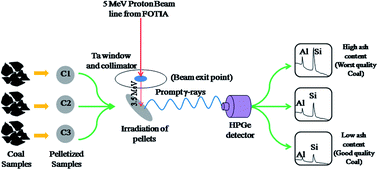The standardization and application of an external (in air) particle induced gamma emission (PIGE) method for the rapid and non-destructive quantification of light elements at major to trace concentrations in coal, bottom ash and coke samples†
Abstract
Coal is an important energy source and its quality evaluation in terms of the ash content and amounts of other elements, like B and F, is a necessity. An external (in air) particle-induced gamma-ray emission (PIGE) methodology using a low-energy proton beam (3.5 MeV) has been standardized for the simultaneous quantification of light (low-Z) elements, namely Si, Al, Mg, Na, F and B, in coal, bottom ash, and coke samples. Current normalization for sample and standard analysis was carried out externally using gamma-rays from a tantalum window, which was used for beam extraction in air. Upon utilizing tantalum current normalization, uncertainty when determining concentrations was improved compared to conventional in situ current normalization. The method was validated via analyzing standard/certified reference materials (SRMs/CRMs). The external PIGE method was found to be suitable, simple, and non-destructive for quantifying low-Z elements in complex matrices like coal, even at trace concentration levels (B and F). The prompt gamma rays emitted from 10B and 11B were utilized for the accurate determination of B with none of the volatilization issues encountered when using wet-chemical methods. The detection limits toward B and F in coal were found to be as low as 2 mg kg−1 and 90 mg kg−1, respectively, using the external PIGE method, which is reported here for the first time. As a quality assurance feature, the ED-XRF method was utilized for quantifying major elements (Si, Al, Mg, and Na), including Fe and Ca. Low-Z elements (Si, Al, Mg, and Na) and elements like Fe and Ca are helpful for determining coal quality in terms of the ash content, building on various other related studies using Al, Na, F, and B. From the results of PIGE and ED-XRF, the ash content levels in coal and coke samples were calculated based on the addition of the concentrations of Si, Al, Mg, Fe, Ca, and Na oxides.



 Please wait while we load your content...
Please wait while we load your content...